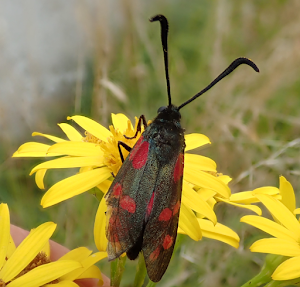Hitchin Cemetery Aug-Sep 2023
Hitchin Cemetery Aug-Sep 2023
The end of summer saw the wildflowers in the meadow areas taking on a brown look and turning to seed. Where the flowers (and insects) did persist, some of them were looking a bit worn, like the Six Spot Burnett moth below.


One plant which flowers later than most is Wild Carrot of which there is a lot growing in the meadow areas, their flowers often having a tiny little spot in the middle just visible, below left. There is a theory that the reason the dark area exists is to try and deter a little parasitic fly (Kiefferia pericarpiicola) which lays its eggs on the seedhead which then develop into tiny pink galls. The idea is that if a fly investigates a seed head and detects the dark area it might reason that a competitor has already laid her eggs there and then move on to the next flower. I'm not sure there is much good evidence for this as this flower from the cemetery has both the dark area and the galls. Below right is Turnip Sawfly which I spotted also taking advantage of the Carrot, quite pretty in my view but maybe not so welcome if you grow turnips.
The cemetery has many lovely looking Silver Birch trees which are a treat to look at in all seasons as well as being good for wildlife (and carbon capture). However I suspect that many of the cemetery trees are getting towards the end of their typical 60 to 90 year life span and one dead one near the chapel was removed in August and the stump ground down.
A notable creature I spotted in August was one of the leafhopper family (some of which make cuckoo spit in spring). This one is called Aguriahana stellulata and is only about 4mm long but a beauty nevertheless. This is only the second sighting in Hertfordshire. I don't suppose it will choose the newly created beetle bank as a home, but maybe hedgehogs will, as we made it with small gap at the rear.
In September the meadow areas received their conservation cut where the long grass is first cut and then removed. This is an important measure to keep the meadows good for wildlife and is quite a labour-intensive task for the contractors who do it. Below are before and after views, and I expect the newly mown areas will turn green again soon.
Despite the grass-cutting activities there were still plenty of insects taking advantage of the warm autumn sun, with a Meadow Grasshopper on a fallen leaf and a Red Admiral getting a bit confused by some plastic flowers.
October will see the cemetery volunteers tidying borders, hedge-cutting, raising the canopy of some low trees to improve views, maintaining graves, trying to reduce the amount of brambles where they threaten to take over and cleaning out bird boxes. I look forward to what autumn will bring.














Comments
Post a Comment